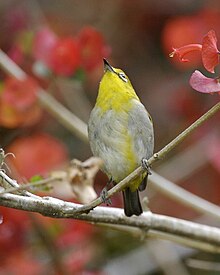| Sangkar white-eye | |
|---|---|

| |
| Conservation status | |
 Vulnerable (IUCN 3.1) | |
| Scientific classification | |
| Domain: | Eukaryota |
| Kingdom: | Animalia |
| Phylum: | Chordata |
| Class: | Aves |
| Order: | Passeriformes |
| Family: | Zosteropidae |
| Genus: | Zosterops |
| Species: | Z. melanurus |
| Binomial name | |
| Zosterops melanurus Hartlaub, 1865 | |
The sangkar white-eye (Zosterops melanurus) is a bird species in the family Zosteropidae. It is also known as the Sunda white-eye. It is found in forested habitats on the Indonesian islands of Java and Bali. In Java it is typically found at elevations between 200–1,600 m (660–5,250 ft), but it sometimes occurs at lower elevations as well.
This species was formerly treated as conspecific with the Indian white-eye (previously the Oriental white-eye, Zosterops palpebrosus), but based on the results of a molecular phylogenetic study published in 2018, it was promoted to species rank.
The sangkar white-eye has two subspecies, Zosterops melanurus melanurus in eastern Java and Bali and Z. m. buxtoni in western Java. (A population of white-eyes on Sumatra that was historically considered part of the latter subspecies may in fact belong to Hume's white-eye.) The two subspecies differ notably in appearance: Z. m. melanurus has entirely yellow underparts, while Z. m. buxtoni has a grey belly. They differ little genetically, however, and commonly interbreed where their ranges overlap.
The sangkar white-eye feeds on insects, and favours the introduced Sesbania grandiflora when hunting. The breeding season is from January to October, with a peak in May and June.
The sangkar white-eye is considered threatened due to extensive trapping for the caged bird trade in Indonesia. It has the unfortunate distinction of being the most heavily trapped and traded wild bird species in the world, and its common name was coined to reflect this: sangkar translates to birdcage in Indonesian.
References
- BirdLife International (2019). "Zosterops melanurus". IUCN Red List of Threatened Species. 2019: e.T155156221A155166244. doi:10.2305/IUCN.UK.2019-3.RLTS.T155156221A155166244.en. Retrieved 18 November 2021.
- ^ van Balen, B (2019). del Hoyo, Josep; Elliott, Andrew; Sargatal, Jordi; Christie, David A; de Juana, Eduardo (eds.). "Oriental White-eye (Zosterops palpebrosus)". Handbook of the Birds of the World Alive. Barcelona: Lynx Edicions. Retrieved 24 January 2019.
- ^ Lim, B.T.M.; Sadanandan, K.R.; Dingle, C.; Leung, Y.Y.; Prawiradilaga, D.M.; Irham, M.; Ashari, H.; Lee, J.G.H.; Rheindt, F.E. (2018). "Molecular evidence suggests radical revision of species limits in the great speciator white‑eye genus Zosterops". Journal of Ornithology. 160: 1–16. doi:10.1007/s10336-018-1583-7. S2CID 51890116.
- Gill, Frank; Donsker, David, eds. (2018). "Sylviid babblers, parrotbills, white-eyes". World Bird List Version 9.1. International Ornithologists' Union. Retrieved 23 January 2019.
| Taxon identifiers | |
|---|---|
| Zosterops melanurus | |